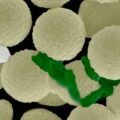What may sound like something out of a science fiction film will actually be helpful to the millions of coffee and tea drinkers around the world: a new material to keep your drink warm… inspired by squid skin.
Designed by a chemical and biomolecular engineering professor at the University of California Irvine, Alon Gorodetsky, the material is built into a sleeve to help insulate a drink. This adaptive material can also be used to help insulate restaurant take-out containers, postage parcels, and possibly even shipping containers. Gorodetsky took inspiration for this next-level technology from the squid’s color-changing centers in their skin, called chromatophores.
Background: The Secrets of Chromatophores
Chromatophores are special cells that help an animal change or produce a certain color. They’re used in multiple animal types, including reptiles, crustaceans, fish, and cephalopods like the squid. Chromatophores have been studied for centuries, as scientists have been captivated by the amazing color shift in these different animals. Charles Darwin even described these abilities in the cuttlefish while traveling on the HMS Beagle, calling them “extraordinary” and “chameleon-like.”
The process of changing color is dependent on the animal. One type of process, called metachrosis, is when the animal changes color by moving pigment and reorienting reflective plates within the chromatophore. Octopuses and other cephalopods do this by using specific muscles triggered by a cell signal. In turn, this cell signal gets triggered by environmental factors, such as predators, temperature, or even stress.
Analysis: From Squid Skin to A Coffee Cozy
It was the change in the shape of the chromatophores that inspired Gorodetsky. He and his team created a composite material made of metal attached in a flexible pattern. “The metal islands in our composite material are next to one another when the material is relaxed and become separated when the material is stretched, allowing for the control of the reflection and transmission of infrared light or heat dissipation,” explained Gorodetsky. This allowed the material to be tunable in the amount of insulation it provides. “The mechanism is analogous to chromatophore expansion and contraction in squid skin, which alters the reflection and transmission of visible light,” he added.
Because of the material’s adaptive design, it is more energy-efficient and cheaper to make. Making the material by the roll is a fraction of what the expected cost was. To make the material, the researchers deposit a copper film onto a reusable surface, like aluminum foil, then spray special polymer layers onto the film. In this way, the team can easily make the composite material in bulk. According to Gorodetsky: “The combined manufacturing strategy that we have now perfected in our lab is a real game-changer. We have been working with cephalopod-inspired adaptive materials and systems for years, but previously have only been able to fabricate them over relatively small areas. Now there is finally a path to making this stuff roll-by-roll in a factory.”
Outlook: A Greener Material
In creating this material, the researchers also realized that this material could be easily recycled, making it more environmentally friendly. “There is an enormous array of applications for this material,” Gorodetsky explained. “Think of all the perishable goods that have been delivered to people’s homes during the pandemic. Any package that Amazon or another company sends that needs to be temperature-controlled can use a lining made from our squid-inspired adaptive composite material.” The researchers are hopeful that with smart materials like theirs, more companies will look into decreasing their use of plastics for shipping or storing. The cost of Gorodetsky’s material shows further incentive for companies to use it. “Now that we can make large sheets of it at a time, we have something that can benefit many aspects of our lives.”
Kenna Castleberry is a staff writer at the Debrief and the Science Communicator at JILA (a partnership between the University of Colorado Boulder and NIST). She focuses on deep tech, the metaverse, and quantum technology. You can find more of her work at her website: https://kennacastleberry.com/

